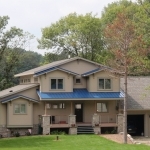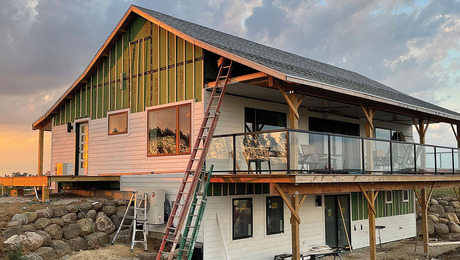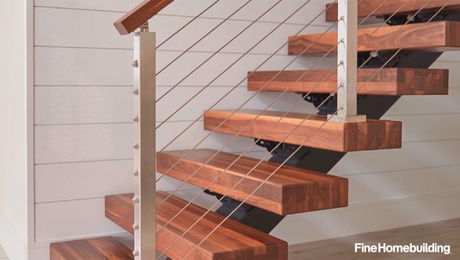Crawlspace Foundation-above grade part

Looking for some thought and opinions. . .
Building a house in WI. Footings need to be 48″ below grade and I want the crawl to be 3-4′ tall. I plan on sealing the crawl and it being climate controlled space. House construction will be conventional framing.
For the lower 4′ of the foundation, it will be poured or block, not sure yet. My question is in regards to the upper 3-4′ of foundation (the “crawl wall”, if you will). What is the best way to approach this?
1) Cap with PT sill and build 2×6 stud walls with OSB or PLY sheathing, insulate and poly the interior.
2) Same as above, but all PT including PT ply sheathing
3) Pour or build block wall up to full height – then how do I insulate? Aparently exposed foam on the walls in that area need to be covered by at least 1/2″ drywall – FG and poly do not.
4) Use ICF’s for all of it and then cover interior foam with ?
That crawl wall will be covered on the exterior with stone veneer or cultured stone veneer. If I use regular stone veneer, then the foundation will need a ledge of some kind – I suppose that if I go with the wood crawl wall, then I will have to cover with ice and water shield that wraps over the ledge?
Thanks for any insight you can offer or experience you can share.















Replies
WHY?
If you are going 4 ft into the ground for the footings and 4ft up in the air why not not just excavate down to the footings and have a basement?
And is there some reason that you want the houe 4ft up in the air?
Fair enough question. Many reasons: high water table, flat lot, overall costs, and (least of all) the home design can support this "look".
I can elaborate if you'd like, but these are the primary advantages to having a crawl and not a basement for this house. I could go with 4 below and 2 above, but I'd hate the idea of working in a cramped crawl.
Here's a drawing that I think would be best, but I'd like other's opinions. The reason for hanging the floor is to avoid the PITA of insulating the Rim-Joist/Floor Joist area.
Insulate the outside up to grade with1' or 2" foam board.
Don't insulate the inside. The wall needs to breathe. I just built an addition with a 6' crawlspace the same way. The crawlspace stays pretty warm and dry.
why would anybody want a crawl. slab on grade is less maintance.
You have to dig the hole for the stem wall anyway, don't you? I don't see filling it in, compacting it, and then pouring a slab would be less work than putting your deck on top of the stem wall. In my case, the six feet below is used for storage and easy access to the wiring and HVAC distribution. To match up to the level of the rest of the house, you have to be above grade. To get 36" of depth below the lowest corner, you end up with a no-brainer. Cutting the basement window into a door gives you access for storage or maintenance.Les Barrett Quality Construction
Don't think I'd get anyone to approve a slab on grade for a residence in WI.
>
why would anybody want a crawl. slab on grade is less maintance.
I've had both. I wouldn't say that a slab was less maintenance. Let anything go wrong with the plumbing under that slab, and you have a royal pain, concrete sawing in the house. The same problem in a crawl gets fixed in the crawl.
To me, the ideal condition is the best of both: a crawl with a rat slab over poly. It gives you a clean, dry place to work. The ideal height is a little over 3 ft. from slab to joists. You can sit on an old cushion and work in the joist bays without hitting your head.
-- J.S.
Thanks for the comment, but don't you think that an un-insulated wall is asking potential freeze problems in Wisconsin (although it is 45 F and raining outside here at the end of December!!!)
Any thoughts on the illustration?
The wall is insulated up to grade. There are several posts available regarding this problem, with some web conncetions. Bottom line - moisture must be able to escape throughout the year. Don't seal a wall all the way up. I have too many things going on right now to give a more detailed answer. Good luck, maybe someone else will remember the details. A search over the last three months will provide you the answers along with some good links.Les Barrett Quality Construction
Thanks Les, I will search for more info using the wonderful prospero search tool (only partially kidding. . .).
I thought that if the crawl was "conditioned space" (heated in the winter and cooled in the summer) that the moisture would not be a problem.
Thanks again for the reply.
BUMP
Hoping some others could take a look at posts 1 and 4 and offer any advice.
Happy New Year to everyone.
Insulating on the outside of the foundation is really the best in that it buts the thermomass on the inside of the foundation. But it does take some detailing.The above ground portions need to be protected from sun and phyiscal damage. And with the below ground you "should" worry about termites, but I don't know how bad they are in your area. And you need to protect it against backfill. But I would go down about 1 ft or maybe 2 below ground. That will help keep those walls warm and thus the "short basement" and thus the house.And really what you are building is as much more of a short basement than a crawlspace.But I would look at http://www.buildingscience.com and brows around there. Not only the building that work, for you climate, but also in the HO section and the research papers there are articles on insulating basements.Not being a builder and not familar with all of the codes I don't know what is the best, but I think that I would lean towards a ICF system.Or you could insulate the inside. I personall like foam glued to the walls and then covered with DW for a "basement". Since yours is not habitable space you might want to look at some of the polyisocyanurate sheet foam. Some of it is available with AL foil surfaces and I think that I have seen one that is approved to be exposed in non-habitable spaces.
Thanks for the link and advice - I will look around there, too.
I just met with a builder and he told me that all the trouble I was taking to avoid the rimjoist/floor joist gap was a waste: the hangers cost money and add labor - "we just squirt foam in there".
I said, "but you told me that all the foam has to be covered with a fire barrier."
He replied that the inspector lets it slide for that area. "If we foamed the wall cavities, they'd need to be covered, but uncovered foam is OK in that gap. . . ." (what a joke)
The whole meeting was a real letdown. I have been doing all that I can to design efficiently (value engineering, to coin a phrase). Anyhow, it did not seem to matter the quote was more than 2x above what we expected. I will redraw a smaller but more complicated house (more roof lines, more foundation corners, etc) and then the price will be down where we can afford it. Seems crazy to me - then again, maybe I just need to GC this myself or find another builder.
I've only seen the floor hung like that when the goal is to get the floor elevation as close to exterior grade as possible. In that case the floor hangers are hanging on the mudsill. Building a pony wall and then hanging the joists... not what you'd see out here.
I also don't see the point in the 12" PT strip of sheathing. I guess there aren't earthquakes in WI but you're losing the shear connection between the mudsill and the rest of the building unless you block all those edges. Lots of extra work in that.
Also, there isn't sufficient clearance between grade and your framing. Your mudsill is only a few inches above grade and you want at least 6" if not more. I assume the strip of PT ply is there because you think it will be wet behind the stone (and it will if there isn't a proper drainage plane, see the current JLC issue on this), but if the PT ply is wet then the framing will be wet too and you're in trouble.
Why not just pour concrete up to the bottom of the floor framing? That would give you a big advantage against water problems behind the stone veneer. Skip the hangers, set the I joists right on the mudsill. Insulate between the joists however you want, and then insulate the inside face of the concrete with foamboard... is there not a foil-faced foam that's appropriately fire resistive?
As with many HO-designing-their-own-house posts I get the feeling that you're scaring the builder... he thinks you'll be hard to build for because you want to detail everything in ways that are not typical. What are your qualifications to be designing the house?
Whenever the grade is to high we have the mason sit an 8" block on top of a 12" block which gives us a ledge on the inside to sit the joist on instead of hanging them and it raises the block above the grade.Joe Carola
Last things first: my qualifications? Next to none. All I know is from learning from reading books and mags, reading here, and having a good "engineering sense" coupled with the sense to ask the pros for advice (and take it when appropos).
You may be right about creating aprehension in the builder. We've talked twice and both times I've said, "You are the pro. I want you to tell me where and when I am off-base. I also want you to tell me how I might be able to improve on any of my ideas. I want to help where I can to save money, but not if you think that my help will be more troule than it is worth. . . "
I have to shoot out the door right now, but I will get back to you on the other points. I appreciate your reply and I will take it into account as the drawings get revised (yet again)
PS - If you know of a fire rated foam board, please let me know about it.
I don't know much about foam board... but I have seen and used foil-faced fiberglass batts that are designed for open installation (as opposed to behind drywall), and the foil is there as a fire retarder. I have seen foil faced foam board also but it's not a typical residential building product. A quick look at Google shows that there may be something that would work inside the crawl without sheetrock. It seems to me that it would be relatively easy to rock and firetape the exterior walls of a crawl space over foam if one had to... shoot on furring strips, glue foam panels between them, install the rock.
The thing is that there is just not that much foam in the rim joist to cause that much problem (smoke generation). And each bay is separate so that you won't have a bunch of them going until you have a REAL FIRE at which point the joist will be colapsing.
Arxx icf's are fire rated and don't have to be covered. Also go to http://www.buildingscience.com .
Jim,
Not that I should be taken as an authoritative voice, but if I ever get to design/build a house, I will be doing everything possible to keep all wood as far above grade as I could manage.
I know it is pressure treated wood, and I know that there are houses with pressure treated wood foundations(!), but I just don't like having wood that close to the ground. Put at LEAST one more course of block than your diagram shows (maybe two more....)
As for how to detail it...with apologies to our host, Taunton Press, JLC had a nice article on crawls in new construction in the Oct. 2003 issue.
It will cost you three bucks for the article, but....
http://www.jlconline.com/cgi-bin/jlconline.storefront/41d5f7b8001791c427177f0000010606/Product/View/0310buil
Rich Beckman
Another day, another tool.
You might want to look at the thread in the General Category here - there currently is a thread on ICFs and fire barrier in a crawl space.
Lots of good information.
Thanks for the note - I just read the whole thread and am looking forward to what your inspector says.
I would LOVE to do my foundation with ICFs - heck, I'd love to do the whole house!!! I have a friend building (GC'ing it himself) an ICF home now and I was planning on showing him the plans and getting his thoughts.
I like the DIY-ability of an ICF foundation, too. I have a nice, flat lot and would not need a pumper either. Seems like bracing would be a breeze it one was only doing a 4-6' foot wall.
. . . staying tuned. . .
You're welcome.
We began putting up the ICFs this afternoon. As we are only going 4 feet we had 3 sides nearly done in about 2 hours. The front has 8
45 degree angles so it will be bit longer to do it tomorrow. My supplier is helping set them up and says the only place we really need to do much bracing is around the 45s. These new ICFs are really nice.
As for my inspector - I talked to him and will be getting a letter from the Mfgr. of the ICFs stating that they are 3 hour rated and are built to not produce toxic fumes. He seemed to be satisfied if I can do that.
I then asked about foaming the rim joists - I knew the larger city next to us allows this w/o a barrier _ but he apparently will not allow it w/o a barrier.
Good luck.
Stee
I got this email and attachment during my research - maybe this will help with your inspector, too.
JIM, YOU COULD USE OUR ASTM E-84 KIT TO COVER YOUR CRAWLSPACE WALLS. THIS WOULD ELIMINATE THE NEED FOR A COVER. IF YOUR INSPECTOR NEEDS TECH DATA SHEETS, I HAVE ATTACHED A PDF COPY OF THIS. IF YOU HAVE FURTHER QUESTIONS PLEASE CALL 1-800-339-3531 OPTION1(SALES), MON.-FRI. 9A.M.-5P.M. CENTRAL. THANKS, SAM ________________________________Sam AlveyCommercial Thermal Solutions, Inc.Fomo Foam Products DivisionPhone: 800.339.3531 Ext. 201Email: [email protected]
Edited 1/6/2005 10:11 pm ET by Jim
Having trouble with the upload of the PDF - will try again
Edited 1/6/2005 10:12 pm ET by Jim
The file is just over 2Meg - I have a high speed connection, but I can't get it to upload. I will try and email it to you.
Jim,
Don't bother with it right now. I belive that with the fire rating and no fume construction of the forms I will not need to cover them. I will get back to you if I find that I will indeed need to cover them.
Thanks,
Steve